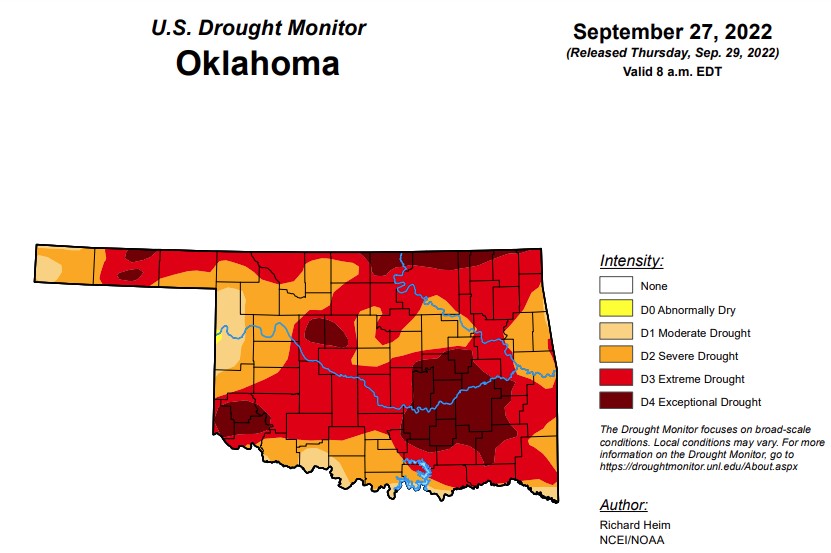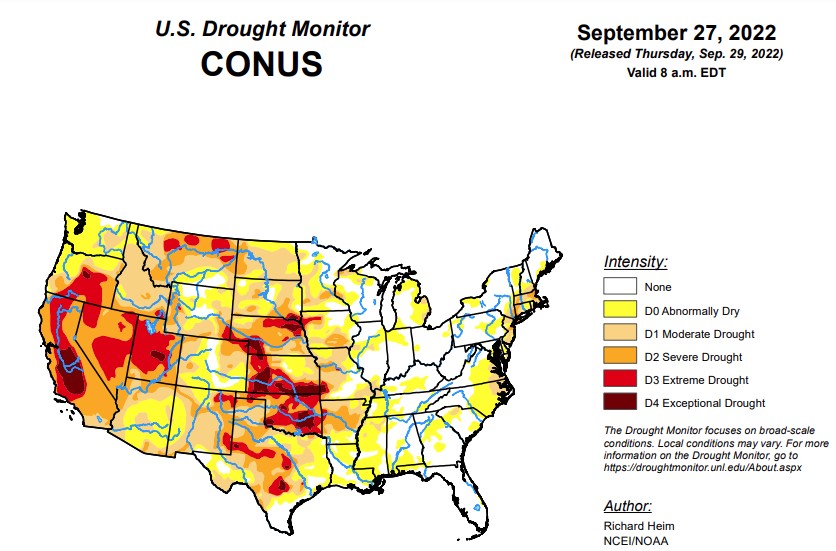
Agricultural News
This Week's Drought Monitor Shows Drought Conditions in Oklahoma Continuing to Rise
Thu, 29 Sep 2022 10:13:32 CDT
 As Oklahoma continues to wait for rain, drought levels intensify in this week’s drought monitor. The statewide average rainfall total of 0.7 inches for Sept. 1-29 places it as the 5th driest September on record for the state dating back to 1895.
As Oklahoma continues to wait for rain, drought levels intensify in this week’s drought monitor. The statewide average rainfall total of 0.7 inches for Sept. 1-29 places it as the 5th driest September on record for the state dating back to 1895.
In Oklahoma, exceptional drought is at 17.25 percent, up from last week’s 13.6 percent.
Extreme drought is now at 64.4 percent, jumping over 10 percentage points from last week’s 53.9 percent.
Severe drought or worse has reached 94.4 percent, up from last week’s 89.25 percent.
Moderate drought or worse is now at 99.8 percent, up slightly from last week’s 98.9 percent.
Abnormally dry or worse conditions have topped off at 100 percent, up from last week’s 99.9 percent.
According to the 6-10-day precipitation outlook map for Oklahoma, the state shows a below-normal chance of precipitation through October 8 in most of the state. The panhandle is leaning above a 33-40 percent chance of precipitation through October 8.
To view the Oklahoma Drought Map, click here.
According to this week’s U.S. Drought Monitor Report, Two upper-level weather systems danced across the contiguous U.S. (CONUS) during this U.S. Drought Monitor (USDM) week (September 21-27). One partner of the pair was an upper-level low pressure trough which twirled from the West Coast to the northern Plains then migrated to the Northeast. The other partner was a high pressure ridge. As they did a kind of do-si-do, the ridge swung from the southern Plains to the western CONUS. Other players danced at the periphery - Hurricane Fiona moved across the Canadian Maritime Provinces, spreading rain over New England at the beginning of the week, while Hurricane Ian brought rain and wind to southern Florida as it bore down on the state just as the week ended. The high pressure ridge brought hot temperatures to the southern states at first, then to the West later in the period. The trough generated a storm track across the northern states, then sent a large cold front into the Southeast as the period ended. Monsoon showers joined in over the Southwest in these waning days of summer. The end result was a weekly precipitation pattern that was wetter than normal over parts of the West, southern Plains, Great Lakes, Northeast, and southern Florida. The rain missed large parts of the West, which received little to no precipitation, and much of the Plains, Mississippi to Ohio Valleys, and Southeast to Mid-Atlantic states were drier than normal as well. Temperatures for the week averaged warmer than normal over the southern Plains to Lower Mississippi Valley and across parts of the Southwest and Northwest. The week ended up cooler than normal from the northern Plains to Northeast and into parts of the Southeast. The hot temperatures and continued dry conditions, especially in the South, further dried soils. According to the U.S. Department of Agriculture (USDA), national topsoil moisture rated very short to short (dry or very dry) reached 54%, a high for the year to date and very close to the recent maximum of 56% achieved on October 18, 2020. This is the third year in a row that a peak greater than 50% has occurred. Drought and abnormal dryness contracted where it rained in the Southwest, Northeast, and southern Florida. Drought and abnormal dryness expanded where it didn’t rain, including the Northwest, Great Plains to Mississippi Valley, and Mid-Atlantic states.
In the Southern Plains, about half an inch of rain fell across a few parts of Texas, Mississippi, and Tennessee, but otherwise the South region was dry this week. Hot and mostly dry conditions were observed this past week especially across the Arkansas-Louisiana-Texas area, with near record high temperatures recorded each day as readings neared the century mark. This marks nearly the third straight week with near cloud-free conditions, with below normal relative humidity for this time of year yielding high evaporation rates. Grounds have quickly dried out over much of the area, which has yielded an increased frequency of small wildfires especially across eastern Texas and portions of southeastern Oklahoma. In southeast Oklahoma, hydrological impacts were increasing as Broken Bow Lake was over 11 feet below conservation pool stage, with Pine Creek Lake down about 5 feet. USDA reports indicated 91% of the topsoil short or very short of moisture in Oklahoma. Rapid drying of soils has occurred in Arkansas, with the USDA statistic exploding from 40% on September 11 to 58% on September 18 and reaching 88% on September 25. According to news reports, fierce heat and drought in Arkansas have limited hay and grass growth; August rains allowed farmers to grow some hay, but farmers still do not have enough to get through the winter. Dried ponds, cracked earth, and no forage (pasture) for farm animals were common, especially in western Arkansas. D0 spread across much of Louisiana, Mississippi, and western Tennessee, with D0-D3 growing in Arkansas and D2-D4 expanding in Oklahoma. D0-D4 expanded in parts of northern, eastern, and central Texas, while contraction of D0-D1 occurred along parts of the Rio Grande River.
In the High Plains, half an inch or more of rain fell across parts of North Dakota and Wyoming, with locally an inch or more in parts of Colorado and Nebraska and over 2 inches in parts of Kansas. But most of South Dakota had less than a fourth of an inch of rain as did large parts of Nebraska and Wyoming. More than 70% of the topsoil moisture was short or very short in Kansas, Nebraska, South Dakota, and Wyoming, according to USDA statistics, with the numbers 67% in Colorado and 54% in North Dakota. According to media reports, heat and drought limited forage production in Nebraska and other drought-stricken areas, forcing cattle producers to weigh hay supplies against herd size for the winter. Many growers chopped drought-damaged crops for silage. D0-D2 were pulled back in a few parts of Wyoming, D0-D3 were trimmed in parts of Kansas and Colorado where the heaviest rains fell, and D3 was deleted in western South Dakota. But drought or abnormal dryness expanded in other parts of the High Plains region states, including North Dakota (D0-D2), Colorado (D0-D1), Nebraska (D2-D3), South Dakota (D0-D4), and Kansas (D0-D2 and D4).
In the West, monsoon showers dumped half an inch to locally 2+ inches of rain over parts of the Four Corners states, while a Pacific weather system gave parts of the northern Rockies half an inch to locally 2+ inches of precipitation. A few spotty areas of California, Nevada, Oregon, and eastern Montana received locally half an inch of precipitation. The rest of the West was dry. Low streams, dry soils, and a combination of hot temperatures with little to no rain prompted expansion of D0 across coastal Washington and Oregon. These conditions contributed to ponds drying up in central to eastern Washington where D1 expanded. In Oregon, most large reservoirs nearly empty to less than 10% full due to the prolonged dry weather. USDA reports indicated 95% of the topsoil moisture was short or very short in Montana, with the values 71% in Oregon and 65% in Washington. D0-D3 expanded in central to eastern Montana. Above-normal rain during this year’s monsoon season has resulted in contraction of drought in the Four Corners states. The rains this week contracted D1-D2 in Arizona and New Mexico. But 5 to 20 years of drought have brought many large reservoirs to very low levels, including Lake Powell which was still only 25% full and Elephant Butte which was 5% full. It will take several years of above-normal precipitation, and springtime melt of many winters of heavy mountain snowpack, to bring these reservoir levels back up.
Looking ahead, during the two days after the Tuesday morning cutoff time for the USDM, Hurricane Ian made landfall across Florida and an upper-level trough moved across the Northeast, with these systems bringing rain to these areas, while another Pacific trough moved into the Pacific Northwest. Dry high pressure dominated most of the rest of the CONUS. For the period September 29-October 4, the Pacific trough will move across the Pacific Northwest and northern to central Rockies, giving these regions 0.5-1.5 inches of rain with locally up to 2 inches. The remnants of Ian will be drawn over the Southeast, spreading a large area of 1-5 inches of rain across the Southeast to Mid-Atlantic states, with locally over 10 inches in parts of Florida. Ian’s rain will stretch into the eastern Tennessee Valley and southern New England, where up to an inch of rain is expected. Little to no precipitation is forecast for the rest of the CONUS where high-pressure ridging will dominate. Temperatures are predicted to be warmer than normal in the West to Great Plains and cooler than normal in the Southeast to Mid-Atlantic states. For the period October 4-12, odds favor above-normal precipitation across most of Alaska and in the Four Corners states, with below-normal precipitation over the Alaska panhandle, northern portions of the West, and much of the Plains to the East Coast. The West and Alaska panhandle are expected to get wetter as the period progresses. Odds favor warmer-than-normal temperatures for most of Alaska and most of the CONUS, except the period may begin cooler than normal along the East Coast.
To view the 6-10 Day Precipitation Outlook Map, click here.
To view the 6-10 Day Temperature Outlook Map, click here.
To view the Monthly Drought Outlook Map, click here.

WebReadyTM Powered by WireReady® NSI
Top Agricultural News
More Headlines...





